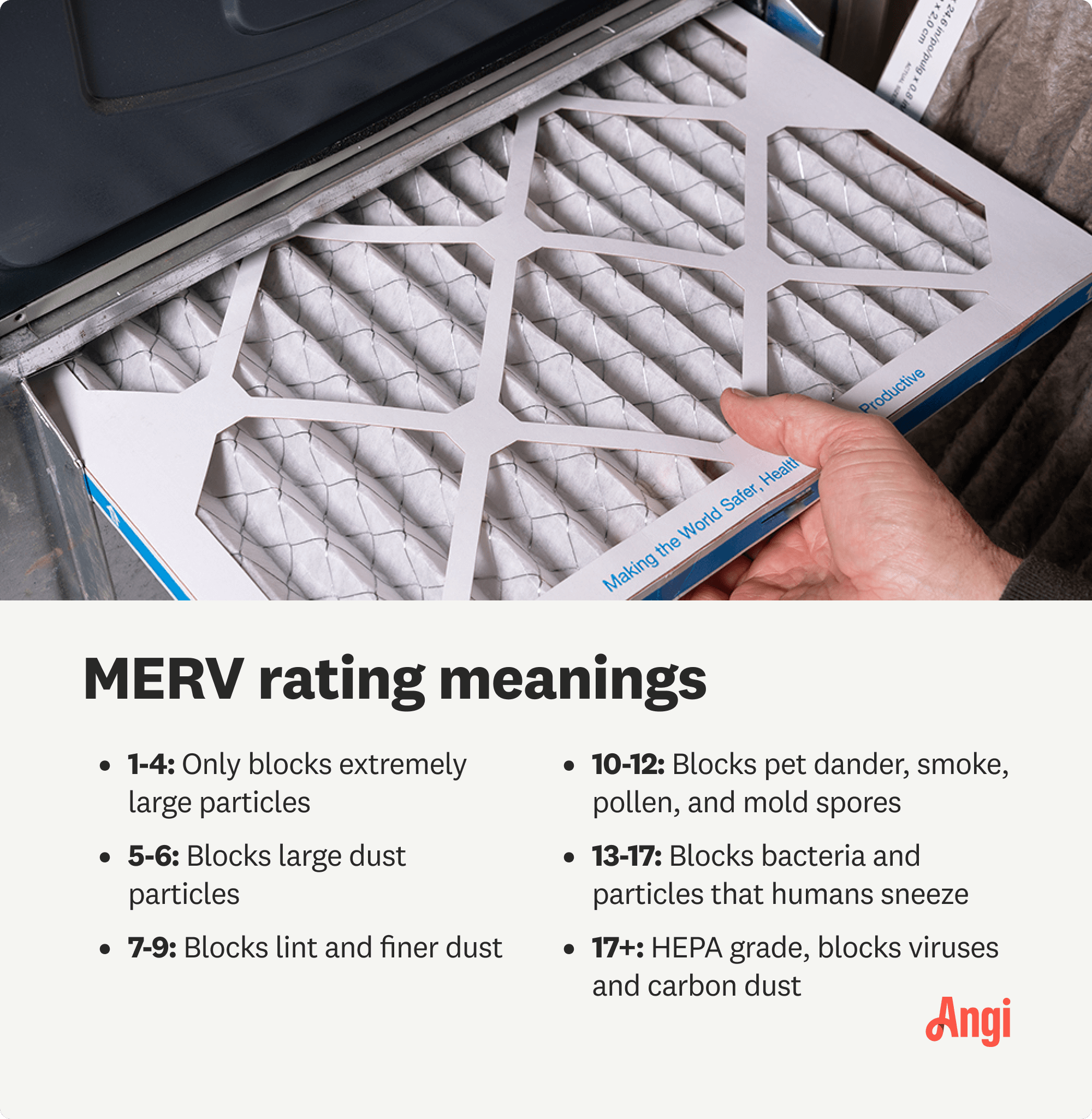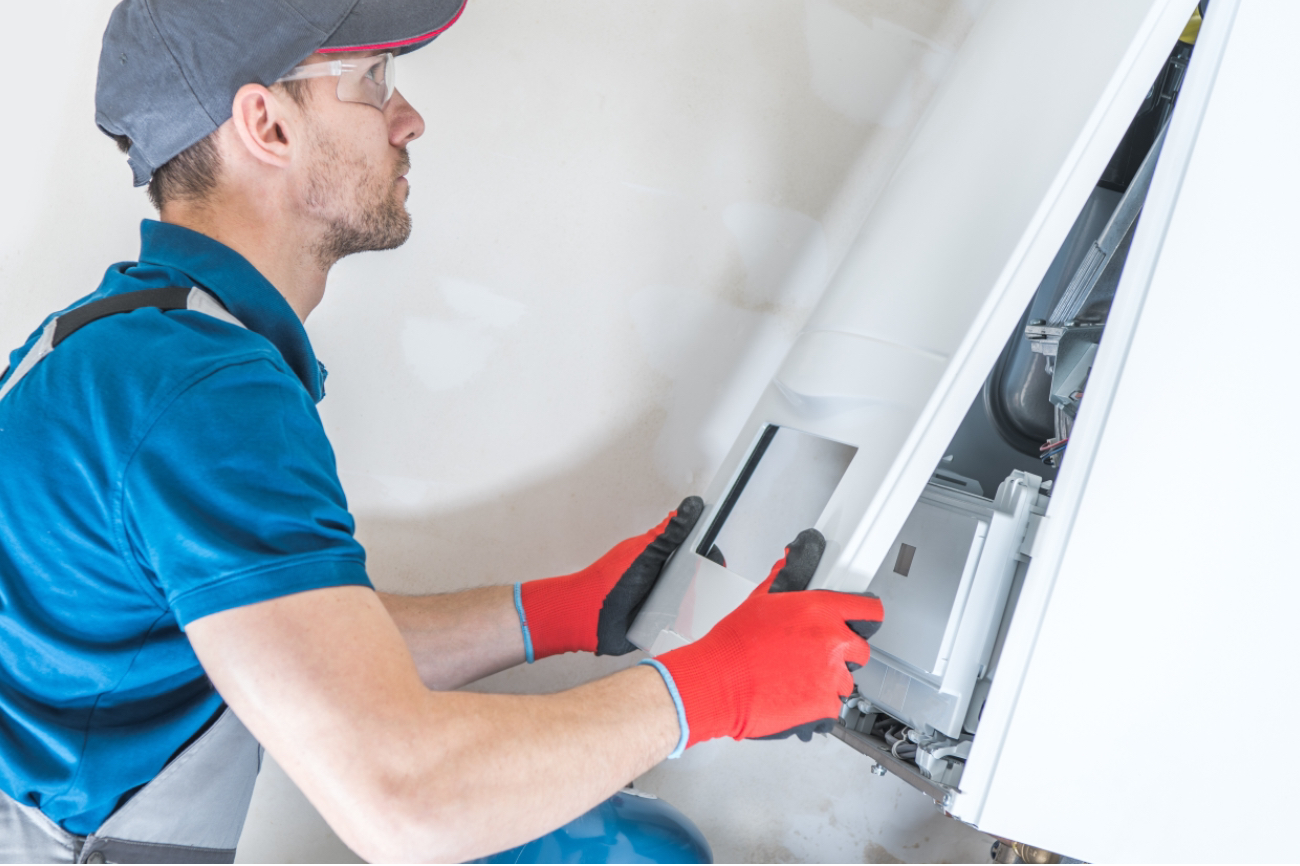
Ductless heating and cooling system costs vary depending on size, type, and energy efficiency. Their installation is likely to lower your energy bills.
Make filter shopping a breeze


The air filter in your HVAC system keeps your furnace and AC working their best by keeping the coils and heat exchangers clean. Air filters also trap dust, mold spores, viruses, and pet dander, ensuring only clean air circulates inside your home. Picking an air filter can seem complex since there are countless options with different rating systems and sizes. Where do you start? That’s where we come in: Our air filter buying guide breaks down the lingo to give you seven tips for choosing the best filter for your home.
| MERV | FPR | MPR |
|---|---|---|
| Best filter for performance and value: MERV 6 | Best filter for performance and value: FPR 5 | Best filter for performance and value: MPR 600 |
| Best for people with pets or allergies: MERV 8–10 | Best for people with pets or allergies: FPR 9 | Best for people with pets or allergies: MPR 1000–1200 |
| Best for people with conditions that impact breathing: MERV 11–12 | Best for people with conditions that impact breathing: FPR 10 | Best for people with conditions that impact breathing: MPR 1500 |
Air filters vary in size, type, thickness, rating, and efficiency. Some air filters are permanent, so you need to clean the filter, but most filters need to be thrown away and replaced once they’re dirty.
You should change your filter at least once every three months to ensure your HVAC system stays protected and your indoor air quality doesn’t take a dip. A dirty filter can overwork your system, leading to increased wear and tear, expensive repairs, higher energy bills, and even ice inside your AC. Running your furnace without a filter can seriously harm your system and cause poor indoor air quality.

There are three different rating scales for air filters: the Minimum Efficiency Reporting Value (MERV), the Microparticle Performance Rating (MPR), and the Filter Performance Rating (FPR). Each rating system was created by a different organization, but they all grade similar attributes, such as what types of particles they trap. No matter the scale, the higher the rating, the more efficient the filter is at trapping debris in the air. However, opting for the highest number isn’t necessary for home use and can even harm your HVAC system.
Here’s a breakdown of the ratings and the best filter rating to choose for each grading system:
The industry standard for air filters is MERV, the rating scale run by the American Society of Heating, Refrigerating, and Air-Conditioning Engineers (ASHRAE). No matter the brand, you can always find the MERV rating. The scale runs from MERV 1 through MERV 16. The larger the number, the more particles it captures.
Recommendation: Opt for a MERV 6 or MERV 8 for the best performance while keeping the cost reasonable. Most MERV 8 filters have pleats and capture mold spores, pollen, and household dust. If someone in your home has a medical condition that impacts breathing, consider MERV 11 or 12, but don’t exceed MERV 13 because the higher-rated filters can damage your system.
Home Depot uses the FPR system for the brands of filters they sell, including Honeywell. The FPR scale runs from 1 to 12, with 1 being the lowest performance and 12 being the highest.
Recommendation: Choose an FPR 5 for residential use, which offers great performance at a reasonable price. Opt for FPR 9 if you have allergies or pets and FPR 10 if you have medical conditions that can make it hard to breathe. An FPR 11 or 12 is unnecessary for residential use and could harm your HVAC system by restricting airflow too much.
3M created the Microparticle Performance Rating (MPR) system to measure how well their filters catch microparticles. The MPR scale runs from 300 to 2800.
Recommendation: Most households can choose MPR 600 to MPR 900, but go for MPR 1000 to 1200 if you have allergies or pets. If you have a medical condition that can make it hard to breathe, level up to an MPR 1500, but don’t go above that for residential use.
An air filter that’s too large won’t fit in your system, and one that’s too small can damage your system and limit what particles it captures. You can find most standard sizes at the local hardware store or online, but you want to be sure you have the correct size.
Here's how to find the proper air filter size for a furnace:
Turn off your furnace at the power source by flipping the circuit breaker to “OFF” on your electrical panel.
Pull out the air filter slider rack. The filter is often located near the blower on the side of your furnace (in a horizontal-facing unit) or near the top and bottom doors (in a vertical-facing unit).
Look to see if the current filter adequately fills the space. If there are gaps along the side, the filter might need to be bigger.
If the filter looks like a fit, look for the size measurements printed on the side of the filter frame.
If you don’t see the size listed or you need a different size than what you currently have, measure the filter with a tape measure. Note the filter's width, length, and thickness in inches. Write down the measurements in the order width x length x depth. That is the exact or actual size of the filter.
Round to the nearest whole number to get the nominal size of the filter (the nominal size is what you will see on the air filter package). For example, a filter that is 19.5 in x 24.5 in x 0.75 in would have a nominal size of 20 in x 25 in x 1 in.
Some HVAC systems have filters inside the return air ducts in different vents and registers throughout the home. You can often buy adjustable or extended filter sizes to match up with these openings.
Most residential HVAC filters are 1-inch thick and offer the necessary filtration, but 4-inch filters are becoming common, too. Four-inch filters can capture more particles and don’t need to be replaced as often. Before you buy a thicker filter, ensure your HVAC system can handle it. A filter that’s too dense can make your HVAC system work harder than it needs to. If you want a thicker filter, work with a local HVAC pro to upgrade your system.
There are several types of air filters: fiberglass, polyester, washable, pleated, and electrostatic. Pleated filters are an ideal pick for homeowners because they offer a larger surface area to capture particles. Electrostatic filters are also a great choice because they're made of charged fibers that trap small and large particles, but they’re not always necessary.
Some furnaces have permanent filters that you clean instead of replace. To clean your filter, vacuum the dust and debris with a shop vac. Then, rinse the filter with water, and let it air dry before placing it back in your furnace.
You should change your air filter at least once every three months. If you live in an older home with lots of dust, an area with high levels of pollution, or you have pets, you may want to change your filter once every month.
Set a calendar reminder in your phone to change your filter so that this important task doesn’t fall by the wayside. If you don't change your filter when it's dirty, your HVAC system will have to work overtime, which can damage the system and increase your energy bills. Plus, the quality of air in your home will suffer.
To change your filter, turn off the power to your HVAC system at the circuit breaker on your electrical panel. Pull out the slider rack to your filter, often located on the side of your unit. Hold the filter up to the light. If light cannot pass through, the filter is too dirty, so you need to replace it. Slide in a new filter in the proper direction (there should be arrows on the filter frame to guide you). Close the rack and turn on the power to your unit once again.
To ensure your HVAC system works optimally and to extend its life span, contact a local furnace maintenance pro for an inspection and routine furnace maintenance. An HVAC tuneup can save you money by preventing inconvenient breakdowns and expensive repairs. A pro can also help ensure you have the best air filter for your home.
From average costs to expert advice, get all the answers you need to get your job done.

Ductless heating and cooling system costs vary depending on size, type, and energy efficiency. Their installation is likely to lower your energy bills.

The average cost of an electric furnace ranges between $1,700 and $7,000, depending on the size, ductwork, and complexity.

When your HVAC system is acting up, it could be the blower motor to blame. See how much blower motor replacement costs and what impacts the price here.

Discover heat exchanger replacement costs to learn about price factors, labor, and ways to save before hiring a pro or starting your project.

Figuring out how to eliminate ductwork noise may require anything from replacing the ducts to changing the filter. Learn more about fixing this issue.

Learning how to secure a window AC unit will avoid personal injury and damage to your home. It will also protect against theft and break-ins.